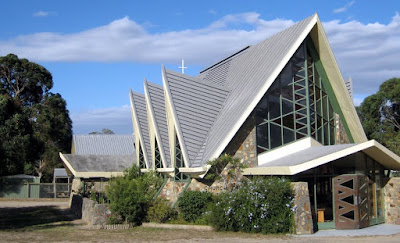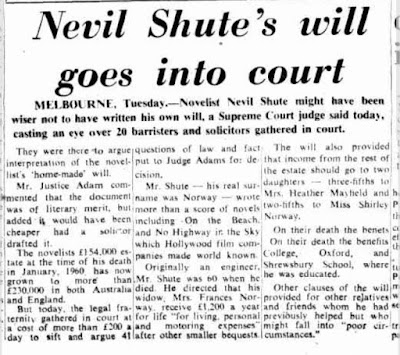I have come across the Strettle family name on many occasions in my historic research - Stratford Strettle was a Stock & Station Agent and conducted many sales in the region. He was also, at one stage, the owner of the property
Tulliallan, then known as
Gladys Park, at Cranbourne (or Berwick as it was often listed as), the property where his brother, William, died. His father, Abraham, owned the property
Sweet Hills at Lysterfield. However, I came across these sad public announcements about the birth and death of Stratford's son and then the death of his wife, Annie, and I thought if anything summed up the precarious life of women where marriage was followed closely by childbirth and childbirth often by the death of the mother or the baby (and sadly in some of the poorer countries around the world today this still happens) then it was these two notices. So I thought we would have a look at the Strettle family.
Bacchus Marsh Express July 14, 1877
We will start the story with Stratford's parents. Abraham Strettle married Mary Sullivan (also sometimes listed as O'Sullivan) in Cork in Ireland in 1835. They had five children, listed below. Mary died in Melbourne on November 14, 1864 at the age of 54 and Abraham died 'at sea of consumption' on March 25, 1876. He was on his way to New York and is buried at the Cypress Hills Cemetery in Brooklyn in New York. Mary did not actually live at
Sweet Hills as she died the year before Abraham took up the property, but you can read about Sweet Hills,
here. According to Stratford's obituary, when he died in 1919 he was a 'colonist of 66 years', which means the family arrived about 1853. According to their daughter Maria's marriage notice (see below) the family had previously been in South Africa (Cape of Good Hope being the name of the area when it was a British Colony)
Maria Strettle's marriage notice. The Age November 25, 1854
The Strettle family were extraordinarily good at putting Birth, Death and Marriage announcements in the papers and if you are a genealogist then this is the sort of family you would want to be related to! From these notices I have discovered the following information about the Strettles. Abraham and Mary Strettle had five children born in Cork in Ireland -
- William, born c. 1838, who died at the age of 47 at the Tulliallan / Gladys Park property on July 15, 1885. Birth date is approximate as it is taken from the death date, so I am not sure if William and Maria were twins or just born really close together.
- Maria, born c. 1838, who died in Victoria at the age of 27 in 1865. Maria married William Minifie on November 22, 1854 and died on January 4, 1865, after a 'long and painful illness' according to her death notice. She had three daughters - Florence Kate, b. 1857, Edith Eveline, b. 1861 and Ellen, born & died 1864. Florence and Edith were listed as beneficiaries in the will of their grandfather, Abraham.
- Katherine (Kate) was born c. 1840 and married William Summers Flint in January 1870, they had three sons - Arthur, b.1871; Walter, b. 1872 and Bertie, b. 1875. When she died in Claremont in Western Australia at the age of 70 on May 27, 1912, her three sons were still alive.
- Ellen, b. c. 1841 and died in Melbourne aged 20 on December 8, 1861.
- Abraham Stratford, born 1845 who died December 19, 1919 aged 74.

Death notice for Ellen Strettle in The Argus December 9, 1861
Death notice for William Strettle The Argus July 21, 1885
http://nla.gov.au/nla.news-article6087477
Back to Abraham Stratford Strettle, known as Stratford. Stratford married Annie Eliza Johnston on April 22, 1868 at St James Cathedral in Melbourne. According to the marriage notice in
The Argus, she was the third daughter of Waldron Johnston of
Fairfield, Malvern. The notice didn't list her mother naturally (they never did) but she was Bridget McIntyre. Waldron was a hotel owner.
Annie and Strettle had three children before the stillborn son who is listed in the announcement at the top of this post
- Ethel Mary, born January 9 and died January 29 in 1869.
- William Stratford, born December 17, 1870. He married Florence Young in 1906 and had three children - Bruce Stratford, b. & d. 1909; Margaret Somerville, b. October 15, 1910 and married Richard Caney in 1942 and Joan Elizabeth, b. 1913 and d. 2003 in Melbourne. William died in Perth on January 4, 1934.
- Stella Kate, born November 13, 1873. Stella married Herbert Powell (c. 1863 - 1941) in Adelaide in December 1894 and died November 9, 1900 in Melbourne at the age of 26. In the seven years between her marriage and her death she had three children - William Hamilton, 1896 - 1936, died in South Africa; Keith, 1898 - 1971 and Stella Kate b. 1900. Little Stella died July 16, 1902 and the death notice lists her as the adopted daughter of James and Alice Cuming, Jnr. Not unusual in those times for a baby to be adopted informally after the death of a parent, especially the mother.
- Unnamed son stillborn in July 1877.
Annie Strettle died without a will but her probate papers said she left an estate of 15, 570 pounds - that was a lot of money in those days, but even all that money could not protect her from the dangers of child birth. Maternal mortality at this time was in the region of 40
to 60 deaths per 1000 births (that means five mothers died per 100 births) and this didn’t
decline until the 1940s, largely due to antibiotics. The infant mortality
rate in Victoria from 1870 to 1900 was anything from 115 to 140 that is
for every 1000 births between 115 and 140 babies would die under the age of
one including Annie and Stratford's daughter, Ethel, and their grandson, Bruce.
In 1878, the year after his first wife, Annie, died Stratford married Jessie Powell (c.1859 - 1932) the daughter of William Hamilton Powell. Stella's husband, Herbert, was also the son of William Hamilton Powell so it looks like Stella married her step-mother's brother. There was one child from the marriage of Stratford to Jessie, and that is Hamilton Stratford Strettle, born December 8, 1887. Hamilton was listed as a motor mechanic when he enlisted in the A.I.F on April 21, 1916. While he was overseas he married Leonie Pickman in Belgium in October 1919 and his occupation then was listed as 'Island trader' - what ever that is, but it sounds romantic. Hamilton Returned to Australia February 1920. In 1931, Hamilton, Leonie and Jessie were living on Point Nepean Road at Rye and he was back to being a motor engineer, clearly no call for the occupation 'Island trader' in Port Phillip Bay. Jessie died May 8, 1932 at the age of 73, Hamilton died in 1960, Leonie in 1974.
Stratford and Jessie lived at
Tulliallan / Gladys Park from 1882 to December 1886 and then leased the property until it was sold 1904 - you would have to surmise that the death of his brother in tragic circumstances from a gun shot wound might have been a factor in his leaving the property in 1886. You can read more about the
Tulliallan /Gladys Park property
here.
Stratford Strettle was, as I said before, a Stock & Station Agent. If you put his name into
Trove you get over 9,000 results, so naturally we wont be listing all his business dealings here, but here are just a few of his advertisements of some of his many activities that took place all over Victoria.
South Bourke & Mornington Journal December 3, 1884
South Bourke & Mornington Journal January 28, 1885
Stratford Strettle died December 19, 1919 aged 74. His obituary, below, said that he lost money in the 1890s collapse of the land boom and, as it appears that he didn't leave a will, we can't tell how much he was worth when he died, but you could assume that he was 'comfortable' if he could afford to own a few trotting horses. But like the death of his first wife, Annie, being well off did not protect you from family tragedy. If you put his family deaths into a time line then it shows how much death touched his family which would have been fairly typical of the time - 1861 - sister Ellen died; 1864 - mother Mary died; 1865 - sister Maria died; 1869 - daughter Ethel died; 1876 - father Abraham died; 1877 son stillborn; 1877 wife Annie died; 1885 - brother William died and 1900 - daughter Stella Kate died; 1902 - grand daughter Stella died.
Stratford Strettle's obituary from The Argus December 23, 1919
South Bourke & Mornington Journal December 25, 1919



























